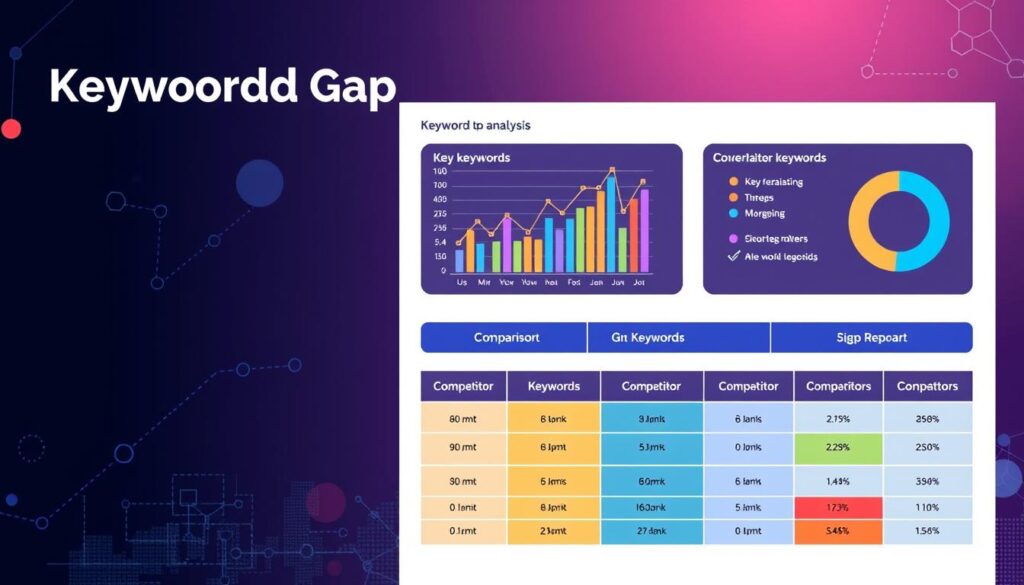Did you know that more than 60% of marketers prioritize SEO as their top inbound marketing tactic? This underscores the imperative for a robust keyword gap analysis strategy to outmaneuver competitors. By executing a keyword gap analysis, you can unearth valuable opportunities that might otherwise remain unexplored. Recognizing the discrepancies between your keywords and those of your competitors can markedly improve your visibility, draw in more traffic, and ultimately boost conversions.
Grasping this analysis transcends mere identification of competitors’ actions; it involves harnessing insights to refine your SEO endeavors. Whether you are a novice in SEO keyword gap analysis or seeking to refine your current strategy, adhering to the correct methodology will propel you towards success. Embark on the journey of keyword gap analysis and discover how to ascend your performance immediately!
Key Takeaways
- Understanding the importance of keyword gap analysis can elevate your SEO efforts.
- Conducting keyword gap analysis helps in identifying missed opportunities.
- A thorough analysis can significantly enhance your content strategy.
- Invest in top tools to streamline your keyword gap analysis process.
- Prioritizing keywords effectively leads to better content creation.
- Measuring success over time is crucial for ongoing strategy adjustments.
What is Keyword Gap Analysis?
Keyword gap analysis is a critical strategy for online enterprises seeking to augment their digital footprint. It entails a comparative examination of your website’s keyword repertoire against that of your competitors. This methodology reveals untapped opportunities, thereby facilitating more precise optimization and targeted marketing endeavors.
Definition and Importance
At its essence, keyword gap analysis uncovers the keywords that competitors leverage but are absent from your digital presence. This technique is of paramount importance, as it illuminates content expansion avenues. A meticulous competitive keyword analysis enables businesses to comprehend their market standing and identify growth potential. In a landscape dominated by search engine optimization (SEO), conducting an SEO keyword gap analysis is indispensable for maintaining a competitive edge.
How it Works
The methodology behind keyword gap analysis is both straightforward and potent. It encompasses several pivotal steps:
- Identify key competitors within your niche.
- Collect a list of keywords that these competitors rank for.
- Compare this list with your own keywords for gaps and opportunities.
- Evaluate search volumes and keyword relevancy.
This systematic approach fosters a deep understanding of the competitive arena, empowering businesses to refine their content strategies effectively.
The Benefits of Conducting Keyword Gap Analysis
Engaging in keyword gap analysis unveils a plethora of advantages, significantly bolstering an entity’s digital footprint. This methodical strategy enables the identification of previously unexplored opportunities, concurrently refining content strategies to better meet audience demands.
Identifying New Opportunities
The foremost advantage lies in the capacity to unearth novel prospects. Through a comparative analysis with competitors, a comprehensive keyword gap analysis report uncovers keywords where rivals excel but you do not. This discovery acts as a blueprint for crafting targeted content, thereby attracting a more specific audience. Capitalizing on these opportunities can substantially elevate traffic and engagement metrics.
Enhancing Content Strategy
Moreover, keyword gap analysis is instrumental in refining content strategies. By discerning which keywords propel traffic to competitors, you can tailor your content to excel in improving keyword performance. This involves creating content that directly addresses the queries of potential customers. By addressing these content gaps, you can cultivate a more robust and impactful online presence, thereby solidifying your industry’s authority.
Employing this strategic analysis equips businesses to adeptly navigate the competitive arena, ensuring they not only maintain but also surpass in delivering content that resonates with their audience. For those seeking a more in-depth exploration, consulting a detailed keyword gap analysis report can offer invaluable insights into optimizing SEO endeavors.
Tools for Conducting Keyword Gap Analysis
The selection of appropriate tools is paramount in refining your keyword gap analysis. A myriad of software solutions exist, each tailored to specific requirements, necessitating a meticulous evaluation of their functionalities. Optimal keyword gap analysis necessitates the utilization of advanced keyword research tools, which facilitate the extraction of competitor insights.
Top Tools to Use
Within the realm of SEO, several tools stand out for their prowess in keyword gap analysis. The following represent the crème de la crème:
- SEMrush: Acclaimed for its exhaustive suite of features, it excels in competitor analysis, delivering detailed reports on keyword performance.
- Ahrefs: Renowned for its vast database, it offers a profound examination of the keywords your competitors dominate, rendering it indispensable for thorough keyword gap analysis.
- Moz: A user-centric option, it streamlines the identification of keyword opportunities and competition assessment, making it accessible to a broad spectrum of users.
Features to Consider
In the process of tool selection, various attributes must be scrutinized. Key considerations include:
- Ease of Use: Opt for tools that boast an intuitive interface and a clear dashboard for metric tracking.
- Data Accuracy: Prioritize tools that deliver precise data, essential for informed decision-making in keyword gap analysis methodologies.
- Reporting Capabilities: Ensure the tool’s capacity to generate exportable reports, facilitating the dissemination of findings to your team.
Investing time in the selection of suitable keyword research tools is crucial for executing an efficacious keyword gap analysis, thereby bolstering your SEO strategy. For additional insights on leveraging your tools to their fullest potential, refer to this resource.
How to Perform Keyword Gap Analysis

Executing a keyword gap analysis strategy necessitates meticulous planning and systematic execution. The acquisition of appropriate competitor data is paramount in unveiling valuable insights crucial for enhancing content and SEO performance.
Step-by-Step Process
Initiate a structured methodology for conducting a competitive keyword analysis:
- Identify your primary competitors. Analyzing brands within similar niches provides a contextual understanding of keyword performance.
- Select target keywords critical to your business, ensuring alignment with customer intent.
- Employ tools such as SEMrush or Ahrefs to aggregate data on the keywords your competitors effectively target.
- Analyze the search volumes and rankings of these keywords to discern gaps in your current strategy.
Gathering Competitor Data
Gathering competitor data entails a deep exploration of their keyword strategies. This can reveal areas where your content may fall short. Consider the following methods for effective data collection:
- Utilize SEO tools that compare your website’s keyword rankings against those of your primary competitors.
- Examine the types of content they produce surrounding specific keywords to evaluate engagement and effectiveness.
- Identify keyword opportunities that your competitors are not capitalizing on. Focus on long-tail keywords or niche-specific terms.
Post-data collection and analysis, a comprehensive plan can be formulated to enhance your keyword targeting efforts. For further insights on this process, refer to this informative article.
Analyzing Competitor Keywords
Delving into competitor keywords unveils crucial insights, pivotal for refining your competitive keyword analysis. Identifying high-performing competitors serves as a foundational step, enabling the adoption of efficacious strategies within your campaigns. The focus on key performance metrics discloses the adeptness of competitors in harnessing their keyword strategies to draw in traffic.
Identifying High-Performing Competitors
Initiate by pinpointing competitors who consistently occupy top positions in search engine results. Seek out entities that share a similar target audience. Utilizing tools such as Ubersuggest and SpyFu can unveil competitors based on shared keywords. Moreover, scrutinizing organic search rankings provides a window into which entities are capturing the most traffic within your niche. By identifying these entities, you can gain a deeper understanding of their strengths and vulnerabilities.
Assessing Keyword Performance Metrics
Post-identification of competitors, delve into their keyword performance metrics. Key metrics to scrutinize include:
- Search Volume: Measures the monthly searches for a keyword.
- Click-Through Rate (CTR): Indicates the ratio of users who click on a link versus those who view it.
- Ranking Position: Displays the specific keyword’s ranking on search engine results pages.
Through the analysis of these metrics, you can glean insights into your competitors’ keyword efficacy and tailor your strategy accordingly. BrightEdge can further augment this analysis by offering comprehensive data on the functionality of specific keywords within the competitive landscape.
Creating a Keyword Gap Analysis Report

The creation of a detailed keyword gap analysis report is pivotal in refining your SEO strategy. This document must articulate findings succinctly and pragmatically, offering profound insights into your existing keyword tactics.
What to Include in Your Report
Your keyword gap analysis report necessitates several fundamental elements:
- Overview of Findings: Provide a concise synopsis of the primary revelations derived from the analysis.
- Data Visualization: Utilize charts and graphs to elucidate intricate data, enhancing comprehension.
- Actionable Insights: Present recommendations grounded in the analysis, aimed at informing strategic decisions.
Presenting Findings Effectively
Effective presentation of findings hinges on several critical strategies:
- Use Clear Language: Eschew technical terms and ensure that all parties can comprehend the information.
- Focus on Key Points: Emphasize the most salient insights that are imperative for decision-makers.
- Engage Your Audience: Stimulate dialogue and inquiry, promoting a collaborative atmosphere.
Closing Your Keyword Gaps
The imperative of addressing keyword gaps cannot be overstated within the realm of SEO. To effectively bridge these gaps, a strategic prioritization of keywords based on their search volume and relevance to the target audience is paramount. This methodology ensures that the efforts invested yield substantial returns, thereby aligning with the overarching keyword gap analysis strategy.
Prioritizing Keywords
The initial step involves a meticulous analysis of the keywords unearthed through the keyword gap analysis. These should be ranked according to several criteria, including:
- Search volume: Target keywords that drive considerable traffic.
- Relevance: Focus on keywords that resonate with your audience’s interests.
- Competition: Assess the level of competition for each keyword; low competition may offer valuable opportunities.
Adopting this structured methodology ensures that your content creation endeavors effectively fill the identified gaps, thereby enhancing your website’s visibility.
Content Creation Strategies
Content tailored to the prioritized keywords significantly enhances your SEO performance. Various content creation strategies can be employed, such as:
- Writing in-depth blog posts that address specific long-tail keywords.
- Developing infographics that simplify complex topics while incorporating relevant keywords.
- Creating video content that engages your audience and leverages SEO-friendly titles and descriptions.
For further insights into optimizing your keyword strategy, refer to this comprehensive guide on unlocking SEO opportunities. Implementing these strategies not only bridges keyword gaps but also fortifies your overall content strategy.
Measuring the Success of Your Keyword Gap Analysis
Understanding the efficacy of your keyword gap analysis is paramount. By monitoring performance evolution, you discern which tactics prove most effective and necessitate refinement. This continuous assessment empowers you to make strategic enhancements, thereby optimizing your SEO endeavors.
Tracking Performance Over Time
Accurate performance tracking necessitates attention to pivotal metrics:
- Traffic growth: Observe the augmentation in organic website traffic.
- Keyword rankings: Examine positional shifts across diverse search engines.
- Conversion rates: Assess visitor engagement, such as purchases or newsletter subscriptions.
Periodic analysis of these metrics affords a nuanced comprehension of your keyword strategy’s efficacy, illuminating the success of your initiatives.
Adjusting Your Strategy
Insights derived from performance tracking mandate proactive strategy refinement. Consider the following strategies:
- Refine keyword choices: Replace underperforming keywords with more pertinent alternatives.
- Optimize content: Periodically update and enhance content to align with current user needs and SEO standards.
- Test new tactics: Explore novel content forms or outreach methods to gauge audience receptivity.
Through relentless success measurement and strategy adaptation, your keyword gap analysis will remain a pivotal driver of organic growth and digital prominence.
Common Mistakes in Keyword Gap Analysis
Keyword gap analysis is a pivotal tool for refining search engine optimization strategies. However, numerous users encounter prevalent errors that impede its efficacy. Recognizing these pitfalls can substantially enhance the outcomes of your endeavors.
Overlooking Long-Tail Keywords
Disregarding long-tail keywords is a common oversight in keyword gap analysis methodologies. These precise phrases more accurately reflect user intent and can attract niche audiences. By concentrating solely on broad keywords, businesses may miss out on substantial traffic opportunities. Incorporating these terms into your strategy can result in more targeted content that aligns with users’ genuine search queries.
Ignoring User Intent
Grasping user intent is paramount in keyword selection. Another prevalent mistake is neglecting the motivation behind search queries. When performing keyword gap analysis, it is crucial to analyze intent to ensure the selected keywords align with audience needs. This understanding fosters more relevant traffic and enhances engagement. Strategies that delve into the motivations behind search queries establish a more profound connection with potential customers. Various keyword analysis techniques can aid in thoroughly evaluating user intent.
Case Studies: Successful Keyword Gap Analyses
Several enterprises have witnessed substantial enhancements through the implementation of keyword gap analyses. These narratives elucidate the myriad of strategies employed, underscoring the pivotal role of identifying these gaps in refining marketing approaches and catalyzing success.
Example One: Business Improvement
An illustrious e-commerce entity harnessed the power of a keyword gap analysis to augment its digital footprint. Through a meticulous examination of competitors, they unearthed a plethora of unexploited keywords pertinent to specialized products. This discovery prompted a comprehensive overhaul of product descriptions and the development of bespoke content. Consequently, this initiative precipitated a marked escalation in organic traffic and sales figures.
Example Two: Content Strategy Shift
A preeminent blogging platform underwent a paradigm shift in its content strategy, facilitated by a keyword gap analysis. By pinpointing lacunae in their existing repertoire, the editorial team crafted novel, pertinent content that resonated with current trends within the community. This strategic pivot not only elevated engagement metrics but also cemented the brand’s stature as a thought leader on critical issues. Such exemplars serve as a testament to the efficacy of rigorous keyword gap analyses in propelling business achievements.
Future Trends in Keyword Gap Analysis
The ever-changing landscape of search engine optimization necessitates a vigilant monitoring of emerging trends in keyword gap analysis for marketers. As algorithms evolve and user behaviors transform, SEO practices are undergoing a metamorphosis. To effectively bridge keyword gaps, a profound understanding of these evolving trends is imperative. Businesses that adeptly identify and capitalize on new opportunities will secure a competitive edge.
Evolving SEO Practices
The imperative for agile SEO strategies that swiftly adapt to rapid changes is becoming increasingly evident. Companies are transitioning from rigid, static methodologies to more dynamic approaches that facilitate continuous reevaluation and adaptation. This flexibility is critical for maintaining digital relevance and enhancing search engine visibility.
The Role of AI and Machine Learning
The integration of AI and machine learning in SEO is revolutionizing the field. These technologies are not only streamlining the process of keyword gap analysis but also providing deeper insights into keyword strategies. Through the analysis of extensive datasets, AI uncovers patterns and opportunities that were previously inaccessible, enabling marketers to make strategic decisions that resonate with the industry’s future trajectory.
